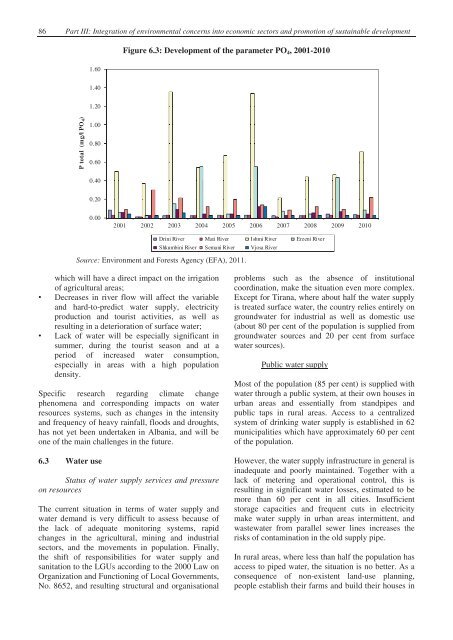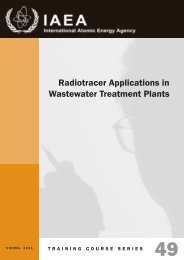Second Environmental Performance Review of Albania
Second Environmental Performance Review of Albania
Second Environmental Performance Review of Albania
You also want an ePaper? Increase the reach of your titles
YUMPU automatically turns print PDFs into web optimized ePapers that Google loves.
86 Part III: Integration <strong>of</strong> environmental concerns into economic sectors and promotion <strong>of</strong> sustainable developmentFigure 6.3: Development <strong>of</strong> the parameter PO 4 , 2001-20101.601.401.20P total (mg/l PO 4 )1.000.800.600.400.200.002001 2002 2003 2004 2005 2006 2007 2008 2009 2010Drini River Mati River Ishmi River Erzeni RiverShkumbini River Semani River Vjosa RiverSource: Environment and Forests Agency (EFA), 2011.which will have a direct impact on the irrigation<strong>of</strong> agricultural areas;• Decreases in river flow will affect the variableand hard-to-predict water supply, electricityproduction and tourist activities, as well asresulting in a deterioration <strong>of</strong> surface water;• Lack <strong>of</strong> water will be especially significant insummer, during the tourist season and at aperiod <strong>of</strong> increased water consumption,especially in areas with a high populationdensity.Specific research regarding climate changephenomena and corresponding impacts on waterresources systems, such as changes in the intensityand frequency <strong>of</strong> heavy rainfall, floods and droughts,has not yet been undertaken in <strong>Albania</strong>, and will beone <strong>of</strong> the main challenges in the future.6.3 Water useStatus <strong>of</strong> water supply services and pressureon resourcesThe current situation in terms <strong>of</strong> water supply andwater demand is very difficult to assess because <strong>of</strong>the lack <strong>of</strong> adequate monitoring systems, rapidchanges in the agricultural, mining and industrialsectors, and the movements in population. Finally,the shift <strong>of</strong> responsibilities for water supply andsanitation to the LGUs according to the 2000 Law onOrganization and Functioning <strong>of</strong> Local Governments,No. 8652, and resulting structural and organisationalproblems such as the absence <strong>of</strong> institutionalcoordination, make the situation even more complex.Except for Tirana, where about half the water supplyis treated surface water, the country relies entirely ongroundwater for industrial as well as domestic use(about 80 per cent <strong>of</strong> the population is supplied fromgroundwater sources and 20 per cent from surfacewater sources).Public water supplyMost <strong>of</strong> the population (85 per cent) is supplied withwater through a public system, at their own houses inurban areas and essentially from standpipes andpublic taps in rural areas. Access to a centralizedsystem <strong>of</strong> drinking water supply is established in 62municipalities which have approximately 60 per cent<strong>of</strong> the population.However, the water supply infrastructure in general isinadequate and poorly maintained. Together with alack <strong>of</strong> metering and operational control, this isresulting in significant water losses, estimated to bemore than 60 per cent in all cities. Insufficientstorage capacities and frequent cuts in electricitymake water supply in urban areas intermittent, andwastewater from parallel sewer lines increases therisks <strong>of</strong> contamination in the old supply pipe.In rural areas, where less than half the population hasaccess to piped water, the situation is no better. As aconsequence <strong>of</strong> non-existent land-use planning,people establish their farms and build their houses in
















